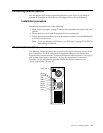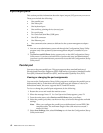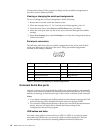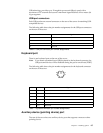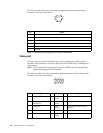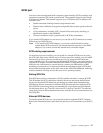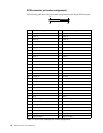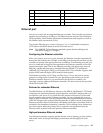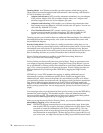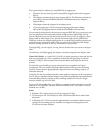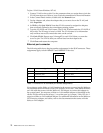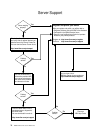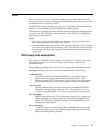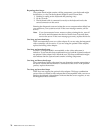
Chapter 5. Installing options 69
Ethernet port
Your server comes with an integrated Ethernet controller. This controller provides an
interface for connecting to 10-Mbps or 100-Mbps networks and provides full-duplex
(FDX) capability, which enables simultaneous transmission and reception of data on
the Ethernet local area network (LAN).
To access the Ethernet port, connect a Category 3, 4, or 5 unshielded twisted-pair
(UTP) cable to the RJ-45 connector on the rear of the server.
Note: The 100BASE-TX Fast Ethernet standard requires that the cabling in the
network be Category 5 or higher.
Configuring the Ethernet controller
When you connect your server to the network, the Ethernet controller automatically
detects the data-transfer rate (10 Mbps or 100 Mbps) on the network and then sets the
controller to operate at the appropriate rate. In addition, if the Ethernet port that your
server is connected to supports auto-negotiation, the Ethernet controller will set the
appropriate duplex state. That is, the Ethernet controller will adjust to the network
data rate, whether the data rate is standard Ethernet (10BASE-T), Fast Ethernet
(100BASE-TX), half duplex (HDX), or full duplex (FDX). The controller supports half-
duplex (HDX) and full-duplex (FDX) modes at both speeds.
The Ethernet controller is a PCI Plug and Play device. You do not need to set any
jumpers or configure the controller for your operating system before you use the
Ethernet controller. However, you must install a device driver to enable your
operating system to address the Ethernet controller. The device drivers are provided
on the ServerGuide CDs.
Failover for redundant Ethernet
The IBM Netfinity 10/100 Ethernet Adapter or the IBM 10/100 Etherjet™ PCI family
of adapters are optional redundant network interface cards (NIC adapters) that you
can install in your server. If you install this NIC adapter and connect it to the same
logical segment as the primary Ethernet controller, you can configure the server to
support a failover function. You can configure either the integrated Ethernet controller
or the NIC adapter as the primary Ethernet controller. In failover mode, if the primary
Ethernet controller detects a link failure, all Ethernet traffic that is associated with it is
switched to the redundant (secondary) controller. This switching occurs without any
user intervention. When the primary link is restored to an operational state, the
Ethernet traffic switches back to the primary Ethernet controller.
High-performance Ethernet modes
Your Ethernet controller supports optional modes, such as teaming, priority packets,
and virtual LANs, which provide higher performance and throughput for your
server.
31 +Data 8 65 -Data 8
32 +Data 9 66 -Data9
33 +Data 10 67 -Data 10
34 +Data 11 68 -Data 11
Pin Signal Pin Signal
Table 10. 68-pin SCSI connector pin-number assignments



